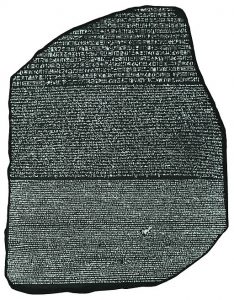Happy New Year to all of you! Let us start the year with something for your inner maths nerd 🙂

For those of you who don’t yet know Rosetta Code: it is a really cool site where you can find lots of interesting code examples in all kinds of different languages for many different tasks. Of course R is also present big time (at the time of writing 426 code examples!): Rosetta Code for R.
The name of the site is inspired by the famous Rosetta Stone of Ancient Egypt which is inscribed with three different versions of the same text: in Ancient Egyptian hieroglyphs, Demotic script, and Ancient Greek script which proved invaluable in deciphering Egyptian hieroglyphs and thereby opening the window into ancient Egyptian history.
Now, a few days ago I again added an example (for the other tasks I solved I will write more posts in the future, so stay tuned!). The task is to verify the correctness of Machin-like formulae using exact arithmetic.
A little bit of mathematical background is in order, so Wikipedia to the rescue:
Machin-like formulae are a popular technique for computing
to a large number of digits. They are generalizations of John Machin]s formula from 1706:
which he used to compute
to 100 decimal places.
Machin-like formulae have the form
where
and
are positive integers such that
,
is a signed non-zero integer, and
is a positive integer.
The exact task is to verify that the following Machin-like formulae are correct by calculating the value of tan (right hand side) for each equation using exact arithmetic and showing they equal one:
![]()
![]()
![]()
![]()
![]()
![]()
![]()
![]()
![]()
![]()
![]()
![]()
![]()
![]()
![]()
The same should be done for the last and most complicated case…
![]()
… but it should be confirmed that the following, slightly changed, formula is incorrect by showing tan (right hand side) is not one:
![]()
This is what I contributed to Rosetta Code:
library(Rmpfr)
prec <- 1000 # precision in bits
`%:%` <- function(e1, e2) '/'(mpfr(e1, prec), mpfr(e2, prec)) # operator %:% for high precision division
# function for checking identity of tan of expression and 1, making use of high precision division operator %:%
tanident_1 <- function(x) identical(round(tan(eval(parse(text = gsub("/", "%:%", deparse(substitute(x)))))), (prec/10)), mpfr(1, prec))
tanident_1( 1*atan(1/2) + 1*atan(1/3) )
## [1] TRUE
tanident_1( 2*atan(1/3) + 1*atan(1/7))
## [1] TRUE
tanident_1( 4*atan(1/5) + -1*atan(1/239))
## [1] TRUE
tanident_1( 5*atan(1/7) + 2*atan(3/79))
## [1] TRUE
tanident_1( 5*atan(29/278) + 7*atan(3/79))
## [1] TRUE
tanident_1( 1*atan(1/2) + 1*atan(1/5) + 1*atan(1/8) )
## [1] TRUE
tanident_1( 4*atan(1/5) + -1*atan(1/70) + 1*atan(1/99) )
## [1] TRUE
tanident_1( 5*atan(1/7) + 4*atan(1/53) + 2*atan(1/4443))
## [1] TRUE
tanident_1( 6*atan(1/8) + 2*atan(1/57) + 1*atan(1/239))
## [1] TRUE
tanident_1( 8*atan(1/10) + -1*atan(1/239) + -4*atan(1/515))
## [1] TRUE
tanident_1(12*atan(1/18) + 8*atan(1/57) + -5*atan(1/239))
## [1] TRUE
tanident_1(16*atan(1/21) + 3*atan(1/239) + 4*atan(3/1042))
## [1] TRUE
tanident_1(22*atan(1/28) + 2*atan(1/443) + -5*atan(1/1393) + -10*atan(1/11018))
## [1] TRUE
tanident_1(22*atan(1/38) + 17*atan(7/601) + 10*atan(7/8149))
## [1] TRUE
tanident_1(44*atan(1/57) + 7*atan(1/239) + -12*atan(1/682) + 24*atan(1/12943))
## [1] TRUE
tanident_1(88*atan(1/172) + 51*atan(1/239) + 32*atan(1/682) + 44*atan(1/5357) + 68*atan(1/12943))
## [1] TRUE
tanident_1(88*atan(1/172) + 51*atan(1/239) + 32*atan(1/682) + 44*atan(1/5357) + 68*atan(1/12944))
## [1] FALSE
As you can see all statements are TRUE except for the last one!
In the code, I make use of the Rmpfr package (from Martin Maechler of ETH Zürich, Switzerland) which is based on the excellent GMP (GNU Multiple Precision) library. I define a new infix operator %:% for high-precision division and after that convert all standard divisions in the formulae to high-precision divisions and calculate the tan. Before I check if the result is identical to one I round it to 100 decimal places which is more than enough given the precision of ![]() , so about 300 decimal places, in the example.
, so about 300 decimal places, in the example.
Please let me know in the comments what you think of this approach and whether you see room for improvement for the code – Thank you!

![Rendered by QuickLaTeX.com \[c_0 \frac{\pi}{4} = \sum_{n=1}^N c_n \arctan \frac{a_n}{b_n}\]](https://blog.ephorie.de/wp-content/ql-cache/quicklatex.com-d1d972bf40ccae6be53f7f2b5dbd9658_l3.png)
Whats the literature reference for this machine like formula:
?- X is 20*atan(29/278)+28*atan(3/79).
X = 3.141592653589793.
Number 5 in your list.
Are you talking about
tanident_1( 5*atan(29/278) + 7*atan(3/79))in my code?What do you mean by “literature reference”?
I guess I found already some older provenance, formula (19) here:
XI. Investigation of a New Series for the Computation of Logarithms ; with a New Investigation of a Series for the Rectification of the Circle. By JAMES Thomson, LL.D., Professor of Mathematics in the University of Glasgow.
in Transactions of the Royal Society of Edinburgh, Band 14,Ausgabe 1
https://books.google.ch/books?id=f0ED_CKR6AsC&lpg=PA223&ots=T9XjaJnuiD&dq=69049993&hl=de&pg=PA223#v=onepage&q=69049993&f=false